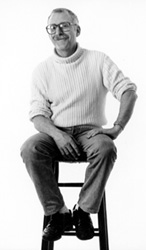Historian Turned Novelist

Details
Haverford's oft-quoted authority on the history of murder in America has turned his attention away from crime and violence to research quite a different topic. For much of his career, Roger Lane has written about the experiences of this country's underclass, of the 19th century urban black communities and European immigrants. In his latest project, Lane has set out to capture what it was like to grow up in middle class America over the past 100 years.
The subject matter is not entirely new for the American social historian, who for several years taught a class at Haverford on the American family. The format of Lane's book project, however, has never been done before. In contrast to the population covered in his earlier books, such as Roots of Violence in Black Philadelphia and Violent Death in the City: Suicide, Accident and Murder in 19th Century Philadelphia, Lane is focusing exclusively on middle and upper-middle class Americans, and what life was like growing up in the 1900s, with special emphasis on the beginning, middle, and end of the century. Through the first-person narrative of a 69-year-old history professor (not unlike Lane, himself), and the faculty member's wife, who is a half-generation younger, Lane is putting together a“multi-generational novel.”
The story opens with the couple in a late-night discussion about their children's college plans and options, and their anxieties surrounding admission into the best universities or“big-time US News colleges.” They begin to question their generation's emphasis on credentialism and decide as a joint project to look at what life was like for earlier generations in their families.
While the characters are fictional, the history behind their families' experiences will be based on Lane's research of actual events and places including some of America's most selective public schools and universities.
“The inspiration for this project came from my musing about growing up,” says Lane. Thinking about the things that interested his teenage daughter in 1999 and what had interested him as a child fifty years ago, he was struck by the similarity of their experiences.“ Things weren't all that different between her generation and mine,” claims Lane.“Like my daughter and her friends, kids in my generation listened to the top 40 on the radio, talked about the previous night's television show, and gossiped on the phone with their friends.
“But, just 50 years earlier – around 1900 – things were very, very different,” says Lane.” The first half of the 20th century witnessed more change in most areas than did the second half – and that included what it was like growing up.”
What Lane has researched about the pace of life in America over the past 100 years debunks many Americans' notion that everything has been speeding up when, in fact, the pace is slowing way down.
“In 1900, the U.S. was just beginning to enter the world scene,” says Lane.“ Cars were just beginning to be used, there were no tanks, airplanes, no submarines, no radar, no hydrogen bomb, no computer.
“In 1900 there were no radios or television,” he adds.“ The hall phone was for messages and emergencies, and middle class kids didn't go on dates. In the absence of organized sports like Little League, summer camps, and the Boy Scouts, children's activities were entirely unstructured. In 1900 the term ‘teenage' hadn't been coined yet.
“In 1950, we had all of those things,” says Lane.
Lane also points out that public schools at the beginning of the century were different in many ways from the classrooms and curricula in the 1950s and today, and colleges were not as selective. Overall, there was a great deal less emphasis placed on acquiring a diploma or degree.“One-half of all the students in Philadelphia, for instance, who attended public school in 1900 dropped out of fourth grade,” says Lane.“Only three of the nation's 86 law schools and 12 of 157 medical schools required a high school diploma. Doctors and lawyers learned their trades in trade schools or as apprentices.
“It was a very different world then, he adds,” and through this project, I want to trace what life was like from that world to now.”
In all, Lane plans to cover the experiences of three generations over the last century – in primary and secondary education, in the relations between the sexes, in the interrelationship between schools and sports, and in collegiate instruction.
“ Using this literally novel form will help me convey the smells and sounds, the boredom and excitement of what the world was really like for young people at different times in the 20th century,” says Lane.



